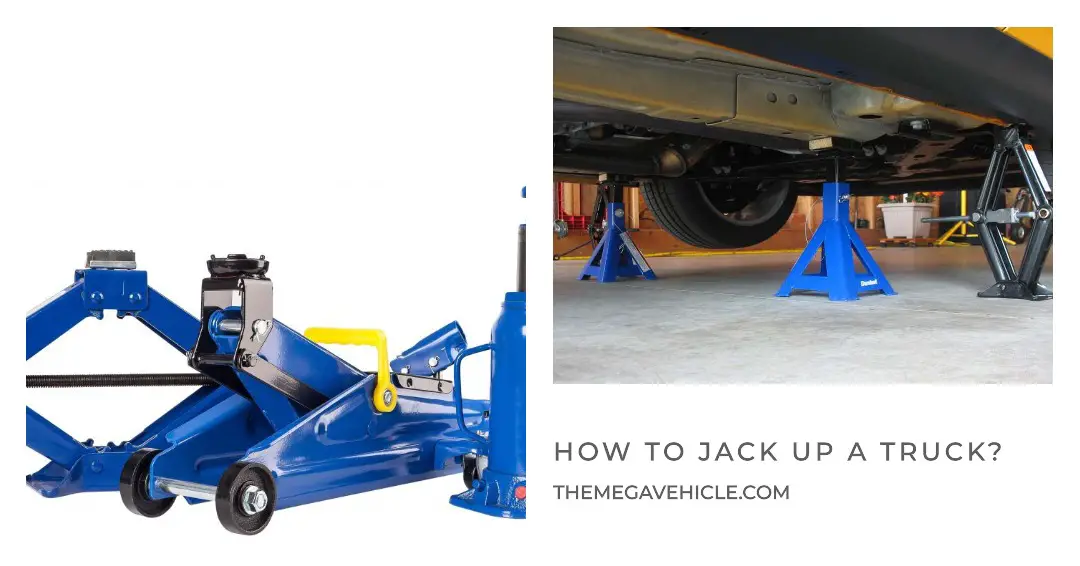How to jack up a truck? Mastering the Art of Jacking Up a Truck

In what circumstances do we need to jack up a truck?
There are a few situations where jacking up a truck is usually required. One common situation is when you need to change a flat tire or perform maintenance underneath the vehicle. You can safely raise the truck using a jack to access the tire or specific components.
Moreover, jacking up the truck becomes crucial if you plan to install larger tires or modify the suspension. This allows you to remove the existing tires and make the necessary adjustments for your desired modifications.
Additionally, when off-roading, there might be instances where your lifted truck gets stuck or high-centred on uneven terrain. In such cases, a jack can help you lift the truck and place additional support under the wheels to regain traction and free yourself.
Depending on your specific situation, there may be many other reasons to jack up your truck. It’s essential to take the proper safety measures when using a jack.
Tools and Equipment Needed
Jacking up a truck requires a few specific tools to ensure a safe and successful process. Here is a list of essential tools you will need:
- Hydraulic jack or floor jack
- Jack stands
- Wheel chocks
- A lug wrench or impact wrench
- Socket set
- Safety goggles
- Safety Gloves
- Creeper or mat
- Penetrating oil
How to jack up a truck: Step-by-Step Process
If you want to jack up a truck, here’s a step-by-step guide. Before we begin, please note that working on vehicles can be dangerous, so it’s essential to follow safety precautions and consult the owner’s manual for your specific truck model.
1. Parking the truck on a flat surface
This will ensure stability and prevent the truck from rolling while you’re working on it. Additionally, make sure to engage the parking brake to further secure the vehicle in place.
2. Choosing the Right Jack and Equipment
When selecting a jack for your truck, it’s essential to consider its weight capacity and lifting range to ensure it can safely support the vehicle. Additionally, using jack stands in conjunction with the jack will provide added stability and prevent any accidents while working underneath the truck.
3. Finding the Correct Lifting Points
When finding the correct lifting points on your truck, performing a thorough undercarriage inspection is crucial to identify the frame rails. These frame rails are typically the strongest and safest points to place the jack and ensure proper lifting without damaging any other components of the vehicle. It is recommended to consult the truck’s manual or seek professional advice to identify these lifting points accurately.
4. Placing the Jack in Position and Raising the Vehicle Carefully
When placing the jack in position, it is crucial to use the correct jacking technique to ensure stability and safety. Additionally, understanding the proper placement of jack points specific to your truck model is crucial for effective lifting. It is also worth considering whether a hydraulic or mechanical jack suits your lifting needs.
5. Safely Supporting the Truck with Jack Stands
Using multiple jack stands is an important safety measure when supporting a truck. This provides additional stability and helps prevent accidents or the truck from tipping over. It is recommended to place the jack stands on sturdy and level ground, ensuring they are positioned under the designated jack points for maximum support. Now you can remove the Hydraulic jack.
6. Test stability
Before fully relying on the jack stands, it is crucial to test the truck’s stability by giving it a gentle push or shake. If there is any wobbling or instability, readjust the jack stand’s position and ensure they are securely in place before continuing with any work underneath the truck.
Once you have properly raised the truck and tested its stability, you can proceed with any necessary maintenance or repairs. Remember to always follow proper safety protocols and use appropriate tools and equipment when working underneath the truck. Additionally, it is recommended to have a second person present as a safety precaution in case of any emergencies.
Lowering the Vehicle and Removing the Jack Stands
After completing your work, when it comes to lowering your vehicle and removing the jack stands, it is important to prioritize safety and take the necessary precautions.
Step 1: Double-check that all your tools and equipment are clear of the work area, ensuring nothing will interfere with the lowering process.
Step 2: Position your hydraulic jack under one of the appropriate jack points and slowly raise the vehicle until it clears the jack stand.
Step 3: Carefully remove the jack stand from its position, ensuring that you maintain a firm grip and watch for any potential hazards or obstacles.
Step 4: Slowly lower the vehicle by using the hydraulic jack, making sure to do so in a controlled manner. Keep an eye out for any signs of instability or issues during this process.
Step 5: Once the vehicle is safely back on the ground, give it a gentle shake to confirm stability before removing the hydraulic jack entirely.
Step 6: Repeat steps 2-5 for each additional jack stand, taking your time to ensure everything is done safely and correctly.
Remember, safety should always be your top priority when working with vehicles. If you need any help or have concerns about completing this task independently, it’s always wise to consult a professional mechanic or seek guidance from an experienced individual.
Mistakes to avoid when lifting or lowering your truck
When lifting or lowering your truck, you must be aware of inevitable mistakes that could lead to safety hazards. Here are some common errors to avoid:
- Failing to secure the truck with the jack properly before beginning lifting or lowering procedures.
- Refrain from checking for any loose or damaged components that could compromise the truck’s stability during the lowering process.
- Rushing through the process without carefully following the manufacturer’s instructions and guidelines for safely lowering a truck.
- Forgetting to release any tension or pressure on suspension components before lowering the truck can lead to damage or accidents.
- Overloading the truck beyond its recommended weight capacity can cause the truck to become unstable and increase the risk of accidents.
- Failing to properly secure any loose items or cargo within the truck before raising or lowering it can result in shifting weight and potential damage.
Frequently Asked Questions:
Q1. Where is the best place to jack a truck?
A. The best place to jack a truck is typically on the frame at the designated lift points recommended by the manufacturer. These areas ensure stability and prevent vehicle suspension or undercarriage damage.
Q2. How high should a jack lift the truck?
A. Typically, a jack should be able to lift the truck high enough to provide sufficient clearance for maintenance or tire changes. Most jacks have a lifting range of around 10-20 inches, which should be enough for most standard trucks. However, it’s essential to consult your truck’s owner manual or contact the manufacturer to determine the exact lifting height recommended for your specific model.
The Bottom Line
Mastering the art of jacking up a truck for any maintenance or repair job is an essential skill for truck owners. By following proper procedures, investing in quality equipment, and prioritizing safety, you can confidently work on your vehicle without compromising your well-being or the integrity of your truck. So, get familiar with the process, practice caution, and enjoy the satisfaction of successfully maintaining your truck.






